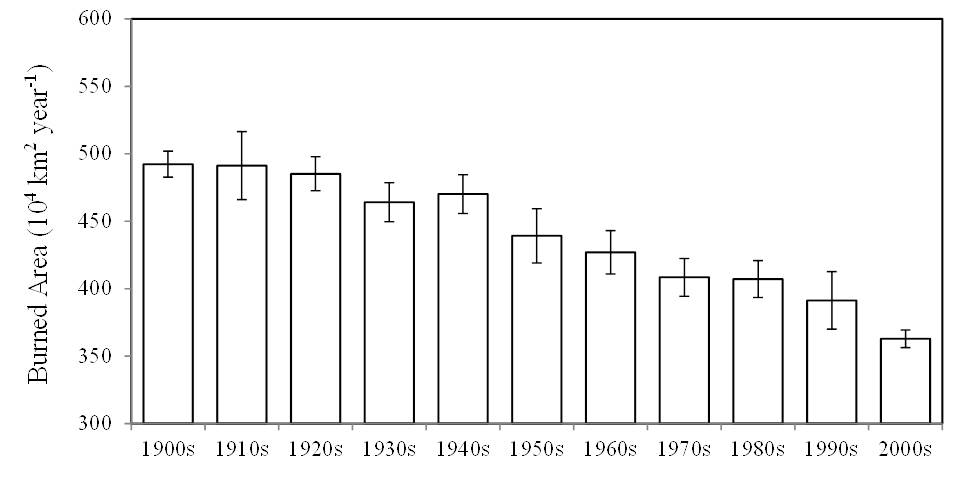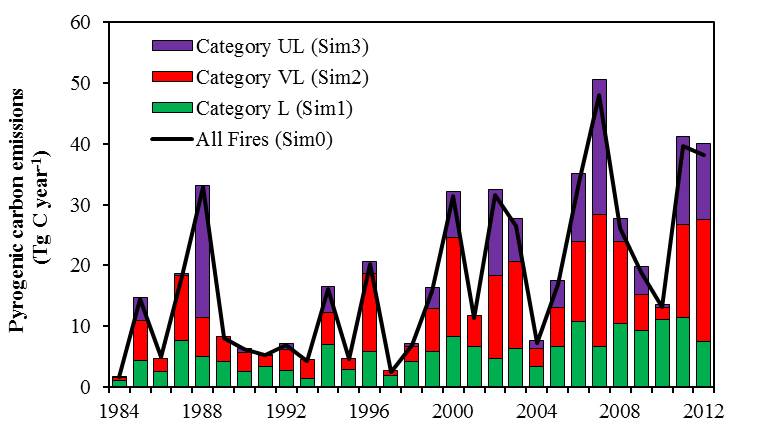Climate-Fire-Ecosystem Interaction
Fire is a critical component of the terrestrial biosphere which have a substantial effect on land surface, climate change, and ecosystem structure and functions. A better understanding of the interaction among fire, climate and human activities is critical to enhancing our capability to predict future fire pattern and inform policy makers about the response of terrestrial ecosystem to increasing fire activity. Our “Climate-Fire-Ecosystem Interaction” project seeks to enhance the understanding of current and future fire dynamics by developing a 0.5 longitude × 0.5 latitude data set of global burned area from 1901 to 2007 by coupling Global Fire Emission Database version 3 with a process-based fire model. Using the newly developed global burned area datasets, we quantified the impacts of fire and other environmental changes on global pyrogenic carbon emissions and its resultant effect on terrestrial net primary productivity and carbon sink.
Our results showed a significant increasing trend in global pyrogenic carbon emissions between the mid-1980s and the 2000s as a result of more frequent fires, particularly in ecosystems with high carbon storage such as peatlands and tropical forests. Fire resulted in large reduction in global terrestrial net primary productivity (4.14 PgC/yr) and carbon sink (0.57 PgC/yr). Our results indicate inform policy makers that special attention should be paid to manage fire activities in the peatlands and tropical forests which store substantial amount of carbon. Below are some of the key findings from our study.
 Figure 1: The DLEM-simulated global burned area from the 1900s to the 2000s.
Figure 1: The DLEM-simulated global burned area from the 1900s to the 2000s.
Major Results:
- Global burned area presented a significant decreasing trend at the rate of -1.28×104 km2 year-1.
- In the 20th century, human activities acted as the dominant factor in determining the downward trend in tropics and extratropics, but their impact was relatively minor at high latitudes.
 Figure 2: The DLEM-simulated global pyrogenic carbon emissions from 1901 to 2010
Figure 2: The DLEM-simulated global pyrogenic carbon emissions from 1901 to 2010
Major Results:
- Global pyrogenic carbon emissions presented a declining trend between the early 20th century and the mid-1980s, but an upward trend between the mid-1980s and the 2000s due to more frequent fires occurred in ecosystems with huge carbon storage.
- Over the 110 years, average pyrogenic carbon emissions were estimated to be 2.43 Pg C year-1. Due to the impacts of fires, net primary productivity and carbon sink of the global terrestrial ecosystems were reduced by 4.14 Pg C year-1 and 0.57 Pg C year-1, respectively.
 Figure 3: The DLEM-simulated pyrogenic carbon emissions from 1984 to 2012 in conterminous United States. The purple, red and green bars represent carbon emissions from fires in different size categories.
Figure 3: The DLEM-simulated pyrogenic carbon emissions from 1984 to 2012 in conterminous United States. The purple, red and green bars represent carbon emissions from fires in different size categories.
Major Results:
- Remote-sensed fire perimeter and burn severity were coupled into the DLEM to estimate fire emissions.
- Average area burned of large fires was 1.44×104 km2 year-1 and carbon emissions induced by large fires were approximately 17.65 Tg C year-1 during 1984-2012.
- Larger fires were generally associated with higher burn severity, and the larger fires became increasingly important in recent decades.

Figure 4: Inter-annual variations in net biome production (NBP) and accumulated NBP in boreal North America from 1960 to 2010. The black line and histogram indicate the overall impacts of all the driving forces on NBP, while the red line and histogram represent the impacts of the enlarged burned area on NBP in Boreal North America.
Figure 5: Changes in the accumulated net biome production (NBP) and four organic carbon pools (i.e., woody debris, vegetation, soil organic carbon, and litter) induced by the enlarged burned area in Boreal North America from 1960 to 2010.
Publications on Fire and Distrubance:
| Publications | Year |
|---|---|
| Yang, J., H. Tian, B. Tao, W. Ren, S. Pan, Y. Liu and Y. Wang. 2016. A growing importance of large fires in conterminous United States during 19842012.JGR Biogeosciences,120:2625-2640. doi:10.1002/2015JG002965. | 2016 |
| Yang, J., Hanqin Tian, Bao Tao, Wei Ren, Chaoqun Lu, Shufen Pan, Yuhang Wang, Yongqiang Liu. 2015. Century scale patterns and trends of global pyrogenic carbon emissions and fire impacts on the terrestrial carbon balance. Global Biogeochemical Cycles,29 doi: 10.1002/2015GB005160 | 2015 |
| Yang, J., H. Tian, B. Tao, W. Ren, J. Kush, Y. Liu, and Y. Wang. 2014. Spatial and temporal patterns of global burned area in response to anthropogenic and environmental factors: Reconstructing global fire history for the 20th and early 21st centuries. J. of Geophysical Research - Biogeosciences 119: 249-263, doi: 10.1002/2013JG002532. | 2014 |
| Chen, G., H. Tian, C. Huang, S. Prior, and S. Pan. 2013. Integrating a process-based ecosystem model with Landsat imagery to assess impacts of forest disturbance on terrestrial carbon dynamics: Case studies in Alabama and Mississippi. 2013. J. of Geophysical Research - Biogeosciences 118: 1208-1224, doi:10.1002/jgrg.20098. | 2013 |
| Xu, X., H.Q. Tian, Z. Pan and CR Thomas. 2011. Modeling ecosystem responses to prescribed fires in a phosphorus-enriched Everglades wetland: II. Phosphorus dynamics and community shift in response to hydrological and seasonal scenarios. Ecological Modeling 222: 3942-3956. | 2011 |
| Tian, H., X. Xu, S. Miao, E. Sindhoj, B.J. Beltran and Z. Pan. 2010. Modeling ecosystem responses to prescribed fires in a phosphorus-enriched Everglades wetland: I. Phosphorus dynamics and cattail recovery. Ecological Modelling 221: 1252-1266, doi:10.1016/j.ecolmodel.2009.12.025. | 2010 |
| Lu, A. and H.Q. Tian. 2007. Fire disturbance, global Change and terrestrial primary production, Journal of Plant Ecology 242-251. | 2007 |
| Lu, A.F., H.Q. Tian, M.L. Liu, J. Liu and J.M. Melillo. 2006. Spatial and temporal patterns of carbon emissions from forest fires in China from 1950 to 2000. J. of Geophysical Research - Atmospheres 111: 12pp. | 2006 |
| LÃÂü, A., H. Tian, and Y. Liu. 2005. State-of-the-Art in quantifying fire disturbance and ecosystem carbon cycle, Acta Ecologica Sinica, 25(10)?2734-2743. | 2005 |
Last modified:
